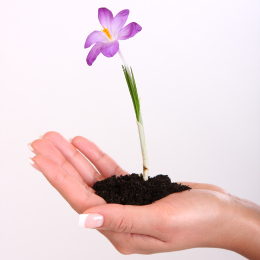Members of the genus Heliotropium, heliotropes are flowering plants that get clusters of unique and fragrant flowers. Read the Buzzle article to learn how to sow heliotrope seeds for a lush spread in your garden.
 Heliotropium convolvulaceum
Heliotropium convolvulaceum, better known as heliotropes, are one of the popular garden flowers with over 220 recognized species. The name is Greek generated "helios" used for sun, and "tropein" used for turn; this is because the plant has a unique habit of facing itself towards the sun, similar to the sunflowers, as the day progresses. This South American old-fashioned perennial shrub was first introduced in Europe in the 1700s and was once called "Cherry pie" plant. During early mornings and evenings, it emits a beautiful fragrance of vanilla-cinnamon mixed together. These plants bloom gorgeous blue, purple, and white flowers annually. Hence, the best time to plant the seeds in your region will be approximately 12 weeks before the last frost is expected. You will have to plant them indoors first, and once spring arrives, the seedlings will be ready to get shifted outdoors.
Usually, heliotropes grow about 1 to 2 feet in height and have bunches of sweet-scented flowers. The dark green leaves are nestled in with the blossoms. Before we get to the instructions on sowing heliotropes, collect the following materials for the job.
Materials Needed
- Heliotrope seeds
- Potting mix, for seed starting
- Fluorescent lights
- Small planting containers
- Granular time-release fertilizer
- Divided seedling tray
- Spray bottle
- Scissors and a spoon
- Protective cover
Step #1: Pour the potting mix into the divided seedling tray for starting seeds. Use the spray bottle to moisten the potting mix. This will settle the mixture into the tray; so make sure you keep adding as much mix as you have to, while watering it, till it reaches all the way to the top of the tray.
Step #2: Now plant only 3 or 4 seeds in each section of the tray. The seeds will be very tiny, so make sure you scatter them at even distance. Once the seeds are placed, sprinkle a thin layer of potting mix as a cover.
Step #3: Place the seedling tray in an area where the temperature will be warm. However, do make sure it receives direct sunlight. If you want, you can use the fluorescent lights to provide the needed supplement. Along with avoiding direct sunlight, steer clear of heating vents, fireplace, air conditioner, and cold drafts from outside.
Step #4: Keep spraying the soil (always with the spray bottle) as much as it's required to keep it moist consistently. But keep in mind, you want the soil moist and not soaking wet. If you make this error, the seedlings will start to rot and won't grow properly.
Step #5: You will have to keep a watch for the seedlings to sprout. As they do, take a pair of scissors and cut the weakest seedlings off. You should only leave one seedling which is the strongest in each section of the tray. Try not to yank them out as it might destroy the root system of the seedlings.
Step #6: Transfer the seedlings into the individual planting containers you purchased once they are too big for the divided trays. If you wish, you can also use Styrofoam or paper cups with a hole underneath it to transfer the seedlings.
Step #7: Once there is no danger of frost, you can plant the heliotrope seedlings outside. Choose a spot which gets constant sunlight all day. Place a layer of protective covering made entirely of organic mulch and place it over the soil. The mulch will enrich it and improve the drainage system.
Step #8: Spoon the seedlings out of the containers very carefully so that you don't damage its root system. Plant them in individual containers and spray some water over the soil to keep it moist.
In order to grow the plants properly, every 6 weeks or so, scatter the time-release fertilizer.






 Heliotropium convolvulaceum, better known as heliotropes, are one of the popular garden flowers with over 220 recognized species. The name is Greek generated "helios" used for sun, and "tropein" used for turn; this is because the plant has a unique habit of facing itself towards the sun, similar to the sunflowers, as the day progresses. This South American old-fashioned perennial shrub was first introduced in Europe in the 1700s and was once called "Cherry pie" plant. During early mornings and evenings, it emits a beautiful fragrance of vanilla-cinnamon mixed together. These plants bloom gorgeous blue, purple, and white flowers annually. Hence, the best time to plant the seeds in your region will be approximately 12 weeks before the last frost is expected. You will have to plant them indoors first, and once spring arrives, the seedlings will be ready to get shifted outdoors.
Heliotropium convolvulaceum, better known as heliotropes, are one of the popular garden flowers with over 220 recognized species. The name is Greek generated "helios" used for sun, and "tropein" used for turn; this is because the plant has a unique habit of facing itself towards the sun, similar to the sunflowers, as the day progresses. This South American old-fashioned perennial shrub was first introduced in Europe in the 1700s and was once called "Cherry pie" plant. During early mornings and evenings, it emits a beautiful fragrance of vanilla-cinnamon mixed together. These plants bloom gorgeous blue, purple, and white flowers annually. Hence, the best time to plant the seeds in your region will be approximately 12 weeks before the last frost is expected. You will have to plant them indoors first, and once spring arrives, the seedlings will be ready to get shifted outdoors.